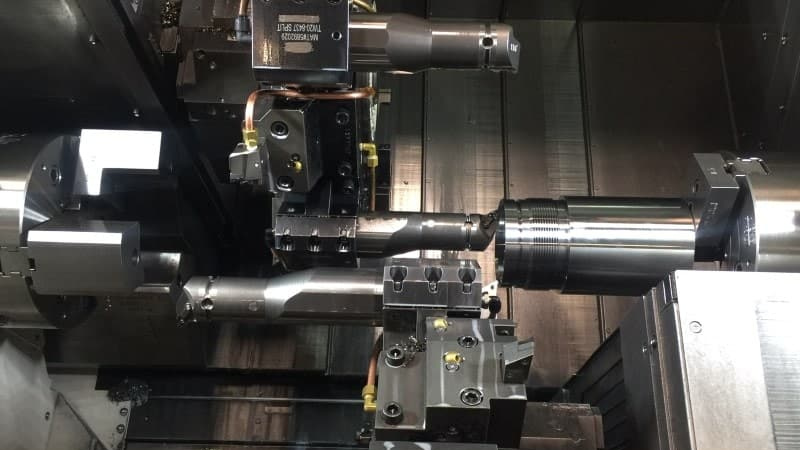CNC (Computer Numerical Control) lathes have become indispensable in various manufacturing industries due to their consistent ability to produce precise, high-quality parts. These machines are designed to automate cutting, shaping, and forming materials, typically metals or plastics, through controlled computer commands. CNC lathing streamlines production and reduces manual labor. It enhances the quality of finished products, making it a preferred choice for automotive, aerospace, and medical equipment manufacturing industries.
However, as with any significant investment, understanding the costs associated with CNC lathing is critical for businesses looking to adopt this technology. Calculating the overall CNC lathe cost goes beyond just the price tag on the machine itself; it involves a comprehensive analysis of various factors such as machine acquisition, operational expenses, tooling costs, labor, and materials. When businesses can accurately assess these costs, they can make well-informed decisions to improve efficiency, optimize production budgets, and ensure profitability.
What is a CNC Lathe?
A CNC lathe is a machine tool that utilizes computerized controls to precisely cut and shape materials, usually revolving around a central axis. In contrast to traditional manual lathes, where an operator directly controls the tool’s position, CNC lathing automates the entire process through programming. This programming uses G-code, a specialized language that provides instructions for the machine’s movements, speeds, and tool changes. CNC lathing can produce parts with high precision and repeatability, making it ideal for complex components in various industries.
The machine typically consists of a spindle that holds and rotates the workpiece and a cutting tool that shapes the material as it spins. The tool’s movement can be controlled in multiple directions to create intricate designs and finishes. CNC lathes can handle various materials, from common metals like steel and aluminum to more specialized materials like titanium or polymers. They are often used to create parts such as screws, bolts, shafts, and other components that need symmetrical shapes along their rotational axis.
How to Calculate CNC Lathe Cost
Calculating CNC lathe cost is a multifaceted process that requires considering all the elements involved in setting up and operating the machine. This includes initial purchase costs, ongoing operational expenses, tooling requirements, labor, materials, and facility overheads. Each factor contributes to the overall cost of using a CNC lathe, so understanding how they interact helps businesses achieve better financial planning and cost management.
- Machine Acquisition Costs
The acquisition cost of a CNC lathe is one of the most significant upfront expenses a business will face. CNC lathe prices vary widely, depending on the machine’s capabilities, size, brand, and features. For instance, entry-level CNC lathes suitable for small workshops may cost anywhere from $10,000 to $30,000. On the other hand, high-end, industrial-grade models with advanced features, like multi-axis capabilities or automated tool changers, can easily exceed $100,000.
Besides the outright purchase, businesses may consider leasing or financing options to spread the cost over time. Leasing can benefit companies wishing to upgrade equipment frequently without large capital outlays. However, this approach comes with interest payments and potentially higher overall costs. Factoring in depreciation and the potential resale value of the machine can also provide a clearer picture of its actual acquisition cost. The decision between purchasing new or used CNC lathes also plays a role, as used machines may have lower upfront costs but could require more frequent maintenance.
- Operational Costs
Operational costs encompass the day-to-day expenses of running the CNC lathe, including energy consumption, routine maintenance, consumables, and cooling fluids. CNC lathing demands significant electrical power, especially with large machines requiring high-speed operations or multi-axis functionalities. Electricity costs are typically calculated based on the machine’s power rating and the duration of use, so higher usage hours directly increase the overall energy expense.
Regular maintenance is crucial for keeping the CNC lathe in top working condition. This includes cleaning, lubricating, calibration, and replacing worn parts such as belts or bearings. Scheduled maintenance minimizes the risk of unexpected breakdowns and costly repairs, though it still incurs expenses that need to be accounted for in the overall cost calculation. Additionally, consumable items, such as cutting fluids or coolants, play an essential role in CNC lathing, as they help maintain the machine’s temperature and improve the quality of the finish. Including these recurring costs provides a more comprehensive view of the CNC lathe cost.
- Tooling and Setup Costs
Tooling costs refer to the expenses associated with purchasing, replacing, and maintaining the cutting tools, tool holders, and other accessories used in CNC lathing. Depending on the material being worked on, the types of tools required may vary significantly. Harder materials like stainless steel or titanium demand specialized cutting tools made from durable materials like carbide or diamond, which can be more expensive. On the other hand, softer materials, such as aluminum, may use standard tooling options with lower wear rates and are more affordable.
Setup costs are associated with preparing the CNC lathe for specific projects. This includes the time required to install the correct tools, configure the machine settings, and program the CNC code. Although the setup time might not appear substantial, optimizing it can lead to significant cost savings, especially for batch production. Minimizing setup time increases productivity, allowing operators to complete more jobs within the same timeframe, thus reducing the overall CNC lathe cost per project.
- Material Costs
Material costs are a fundamental component of CNC lathing, as they vary widely depending on the type and quantity of material required. Common materials include metals like steel, aluminum, copper, or brass, and non-metals such as plastics or composites. These materials’ prices fluctuate based on market demand, availability, and quality grade. High-grade materials, often used for aerospace or medical applications, can be significantly more expensive than standard materials due to their stringent quality requirements.
Another consideration when calculating material costs is the waste produced during machining. CNC lathing typically generates some scrap material due to the cutting and shaping. Effective programming and toolpath optimization can help minimize waste, thereby reducing costs. Companies can also explore recycling programs or repurposing leftover materials for smaller projects to better use resources and control expenses.
- Labor Costs
While CNC lathes automate many aspects of the machining process, skilled operators must program, set up, and oversee the operations. The labor costs will vary based on the experience and qualifications of the machinists. More experienced operators typically command higher wages because they can handle complex tasks, troubleshoot problems, and maintain high precision standards. Moreover, ongoing training may be needed to ensure the operators stay updated with the latest technology or software upgrades.
The efficiency of the labor force also impacts overall costs. Reducing machine downtime through efficient scheduling, using automation for tool changes, and optimizing workflows can lower labor expenses. Additionally, assigning multiple machines to one operator (where feasible) helps maximize productivity without substantially increasing labor costs. Factoring labor costs into the CNC lathe cost calculation provides a realistic view of how personnel expenses affect overall profitability.
- Overhead and Facility Costs
Overhead costs are often overlooked, yet they play a significant role in the total cost of a CNC lathe. These include factory rent, utilities (beyond machine energy consumption), insurance, and any other fixed costs associated with running a production facility. Expanding a facility to accommodate more machinery or upgrading the infrastructure to support higher power requirements may also lead to increased overhead expenses.
Utilities extend beyond the electricity the CNC lathe uses; heating, ventilation, and air conditioning (HVAC) can also add to operational costs, particularly in large or temperature-sensitive manufacturing environments. Insurance premiums for machinery protection and liability coverage further contribute to facility-related expenses. Including overhead costs in the CNC lathe cost calculation helps businesses set realistic prices for their products and services.
How to Accurately Calculate CNC Lathe Cost
Adopting a step-by-step approach that breaks down each cost component is essential to accurately calculate CNC lathe cost, allowing for a clearer understanding of how expenses add up. Here’s a simple guide to follow:
- Calculate the Machine Hourly Rate: This rate is derived by dividing the total acquisition cost (including any interest for financed purchases) by the expected number of operating hours throughout the machine’s lifespan. For example, if a machine costs $50,000 and is expected to run for 10,000 hours, the machine’s hourly rate would be $5 per hour.
- Estimate Operational Costs Per Hour: Add the estimated energy costs, maintenance expenses, and consumable costs, then divide by the total number of operational hours. This will give a per-hour rate for running the machine.
- Include Tooling and Setup Costs: Calculate the average tooling expenses based on tool wear and replacement intervals and setup time for specific jobs. If more appropriate, these should be factored into the hourly cost or added as a per-job cost.
- Account for Material Costs: Material costs should be based on the amount used for each job, including a margin for waste. Multiplying the unit price by the total quantity required for each project gives an accurate material cost estimate.
- Factor in Labor Costs: Multiply the operator’s hourly wage by the estimated time required for each project, factoring in setup and monitoring. Depending on the production setup, this can be done on a per-job or hourly basis.
- Add Overhead Costs Per Hour: Overhead costs can be divided by the annual number of operational hours to find a per-hour rate. Including these costs ensures that all business expenses are covered.
- Combine All Components: Add the hourly machine rate, operational costs, tooling and setup costs, material costs, labor, and overhead to arrive at the total CNC lathe cost per hour or project.
Conclusion
Understanding the full scope of CNC lathe costs is crucial for businesses aiming to optimize their manufacturing processes and improve profitability. Companies can accurately determine the total CNC lathe cost by carefully analyzing all the contributing factors—machine acquisition, operational expenses, tooling, material, labor, and overhead. This holistic approach to cost calculation allows businesses to identify areas where expenses can be reduced and resources better utilized.
Effective cost management helps set competitive pricing and ensures that businesses can maintain a healthy profit margin. As CNC technology evolves, staying informed about the factors influencing CNC lathing costs will empower businesses to make strategic decisions and sustain their growth in an ever-competitive manufacturing landscape.




